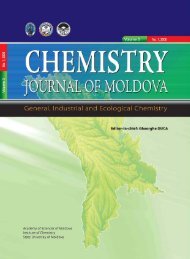stiinte med 1 2012.indd - Academia de ÅtiinÅ£e a Moldovei
stiinte med 1 2012.indd - Academia de ÅtiinÅ£e a Moldovei
stiinte med 1 2012.indd - Academia de ÅtiinÅ£e a Moldovei
Create successful ePaper yourself
Turn your PDF publications into a flip-book with our unique Google optimized e-Paper software.
238<br />
Rezumat<br />
Articolul este consacrat sindromului puţin cercetat în<br />
psihiatrie şi anume cleptomania. Această noţiune a apărut<br />
la începutul secolului XIX, perioadă în care mentalitatea şi<br />
morala popoarelor din Europa se baza mai mult pe poruncile<br />
bibleice, una dintre care era ,,să nu furi”.<br />
Pe parcursul a două secole în rezultatul mai multor<br />
revoluţii, a două războaie mondiale şi mai ales, în urma<br />
procesului <strong>de</strong> secolarizare a opiniei publice, s-a produs o<br />
schimbare esenţială în atitudinea populaţiei faţă <strong>de</strong> proprietatea<br />
privată, fiind zdruncinate bazele morale ale acestei<br />
atitudini. Toate acestea au dus la creşterea bruscă a<br />
numărului <strong>de</strong> furturi. Autorul în baza unui vast material clinic<br />
ce se referă la domeniul psihiatriei limitrofe a <strong>de</strong>monstrat<br />
că: a) al doilea criteriu MKB-10 (,,individul simte o<br />
tentaţie puternică <strong>de</strong> a fura...”) în a stabili existenţa cleptomaniei<br />
este prezent în orice act <strong>de</strong> furt în scopuri meschine<br />
(furt nepatologic); b) în toate cele peste 100 <strong>de</strong> cazuri,<br />
analizate <strong>de</strong> autor, din domeniul psihiatriei limitrofe nu au<br />
fost înregistrat nici un caz <strong>de</strong> furt fără scopuri meschine,<br />
<strong>de</strong> acăpărare.<br />
Au fost făcute următoarele concluzii:<br />
1. Toate furturile, mai ales cele repetate, au fost<br />
manifestări patologice ale psihicului, <strong>de</strong> regulă, în baza<br />
tulburărilor cerebro-organice, dar cu păstrarea atitudinii<br />
critice faţă <strong>de</strong> actul <strong>de</strong> furt comis;<br />
2. Verdictul <strong>de</strong>spre existenţa sindromului <strong>de</strong> cleptomanie<br />
la pacientul cu manifestări psiho-patologice limitrofe<br />
trebuie revizuit şi înlocuit cu noţiunea <strong>de</strong> tulburări <strong>de</strong> comportament<br />
<strong>de</strong> tip <strong>de</strong>viant sau <strong>de</strong>licvent;<br />
3. Cleptomania este un furt <strong>de</strong>zinteresat efectuat <strong>de</strong><br />
un om bolnav, <strong>de</strong>ment, un furt săvârşit sub influenţa unei<br />
tentaţii impulsive în lipsa unui control valitiv.<br />
Summary<br />
This article is <strong>de</strong>dicated to syndrome that is less researched<br />
in psychiatry especial – kleptomania. This theory<br />
appeared at the beginning of XIX century, the period that<br />
the mentality and morally of people from the Europe was<br />
based on biblical or<strong>de</strong>r, one of it being “do not steal”.<br />
During of the tow century long in results of many<br />
revolutions, of two world wars, and especially following<br />
the secularization of public opinion, has being produced<br />
an essential changed of people attitu<strong>de</strong> about privet propriety.<br />
However all this factors have leads to the theft. The<br />
author is refer in the base of wi<strong>de</strong> clinical material in psychiatry<br />
<strong>de</strong>monstrated that: a) the second criteria MKB-10<br />
(“the person feels the temptation to steal”) to establish the<br />
existence of kleptomania is present in any acts of theft (unpathological<br />
theft). b) over 100 of cases analyzed by author<br />
there was no registrated any cases in theft in aim of petty.<br />
There was ma<strong>de</strong> the following conclusion:<br />
1. All thefts a specially those repeated was a pathological<br />
manifestation of psychiatry, as a rule, in base of disor<strong>de</strong>rs<br />
cerebro-organics, but with keeping of critical attitu<strong>de</strong><br />
of theft act.<br />
2. The veridict of existence of syndromes of kleptomania<br />
to the patients with psycho-pathological manifestation<br />
Buletinul AŞM<br />
should to be revised and changed by disor<strong>de</strong>rs of behavior<br />
of <strong>de</strong>viant or <strong>de</strong>licvent type.<br />
3. The kleptomania is a disinterested theft effectuated<br />
by an ill patients, <strong>de</strong>mental, is a theft committed un<strong>de</strong>r impulsive<br />
temptation of lack of volitional control.<br />
PRINCIPII DE RECUPERARE KINETICĂ<br />
A PERSOANELOR CU ACCIDENT<br />
VASCULAR CEREBRAL ISCHEMIC<br />
ÎNCEPÂND CU PERIOADA HIPERACUTĂ<br />
A MALADIEI<br />
_______________________________________<br />
Ion Pârţac, cercetător ştiinţific, Laboratorul <strong>de</strong><br />
Neurobiologie şi Genetică Medicală,<br />
USMF ,,Nicolae Testemiţanu”<br />
Introducere<br />
Actualmente acci<strong>de</strong>ntul vascular cerebral (AVC)<br />
reprezintă una dintre principalele probleme <strong>med</strong>ico-sociale<br />
contemporane. AVC-ul se caracterizează<br />
printr-o inci<strong>de</strong>nţă şi o prevalenţă sporite ale patologiei,<br />
ce provoacă un grad înalt <strong>de</strong> letalitate şi dizabilitate.<br />
În ţările <strong>de</strong>zvoltate, din 100 000 locuitori,<br />
aproximativ 150 <strong>de</strong> persoane fac anual AVC ischemic<br />
[5, 7, 12].<br />
Din punct <strong>de</strong> ve<strong>de</strong>re al mortalităţii, această patologie<br />
se plasează pe locul trei, după bolile cardiovasculare<br />
şi cancer, în SUA sunt înregistrate circa<br />
160 000 <strong>de</strong> <strong>de</strong>cese anuale, cu 4.8 milioane <strong>de</strong> supravieţuitori.<br />
În SUA la fiecare 53 <strong>de</strong> secun<strong>de</strong> este înregistrat<br />
un caz <strong>de</strong> AVC. Inci<strong>de</strong>nţa generală a AVC-ului<br />
în Europa este estimată la 127 000 cazuri pe an în Germania,<br />
112 000 / an în Italia şi 101 000 / an în Marea<br />
Britanie, 75% dintre care sunt AVC-uri primare. Din<br />
punct <strong>de</strong> ve<strong>de</strong>re al dizabilităţii este cea mai frecventă<br />
cauză <strong>de</strong> handicap sever dobândit la adult: cel puţin<br />
30% din supravieţuitorii AVC-ului sunt restabiliţi incomplet<br />
şi alte 20% necesită asistenţă în activitatea<br />
cotidiană, astfel impunând cheltuieli semnificative<br />
pentru îmbunătăţirea calităţii vieţii [4, 5, 12].<br />
O metodă importantă <strong>de</strong> soluţionare a problemei<br />
este perfecţionarea structurii şi conţinutului programelor<br />
integrate <strong>de</strong> recuperare, în special a disfuncţiilor<br />
motorii, luându-se în consi<strong>de</strong>raţie faptul că eficacitatea<br />
obţinerii unor rezultate prin tratamentul recuperator<br />
sca<strong>de</strong> odată cu trecerea timpului după apariţia<br />
AVC-ului ischemic [2, 15].<br />
Succesul tratamentului în AVC <strong>de</strong>pin<strong>de</strong> <strong>de</strong> cinci<br />
factori [4]:<br />
1. Detectarea rapidă a semnelor timpurii ale bolii;

















